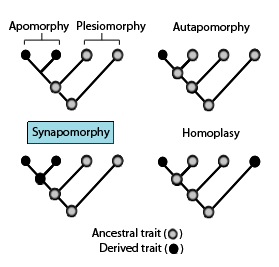Apomorphy and synapomorphy
This article needs additional citations for verification. (October 2009) |

In phylogenetics, a synapomorphy is a shared derived character or trait state that distinguishes a clade from other organisms.[1] In other words, it is an apomorphy shared by members of a monophyletic group, and thus assumed to be present in their most recent common ancestor. The word synapomorphy, coined by German entomologist Willi Hennig, is derived from the Greek words σύν, syn = shared; ἀπό, apo = away from; and μορφή, morphe = shape.
Discussion
A derived character is a character that is derived from an ancestral character over evolutionary history.[2] Derived characters are used in determining phylogenetic relationships. In phylogenetics, a derived character of a clade that has been inherited from a common ancestor and distinguishes the clade from other potentially related organisms is called a "synapomorphy" – a shared ("syn") character that sets the clade apart ("apo").[3]
The concept of synapomorphy is relative to a given clade in the tree of life. What counts as a synapomorphy for one clade may well be a primitive character or plesiomorphy at a less inclusive or nested clade. For example, the presence of mammary glands is a synapomorphy for mammals in relation to tetrapods, but is a plesiomorphy for mammals in relation to one another, e.g., rodents and primates.
References
- ^ a b Roderick D.M. Page; Edward C. Holmes (14 July 2009). Molecular Evolution: A Phylogenetic Approach. John Wiley & Sons. ISBN 978-1-4443-1336-9.
- ^ Concise Encyclopedia Biology. Tubingen, DEU: Walter de Gruyter. 1996. p. 366. Archived from the original on August 28, 2008. Retrieved 7 May 2015.
{{cite book}}: Unknown parameter|deadurl=ignored (|url-status=suggested) (help) - ^ Barton, Nicholas; Briggs, Derek; Eisen, Jonathan; Goldstein, David; Patel, Nipam (2007). "Phylogenetic Reconstruction". Evolution. Cold Spring Harbor Laboratory Press.
